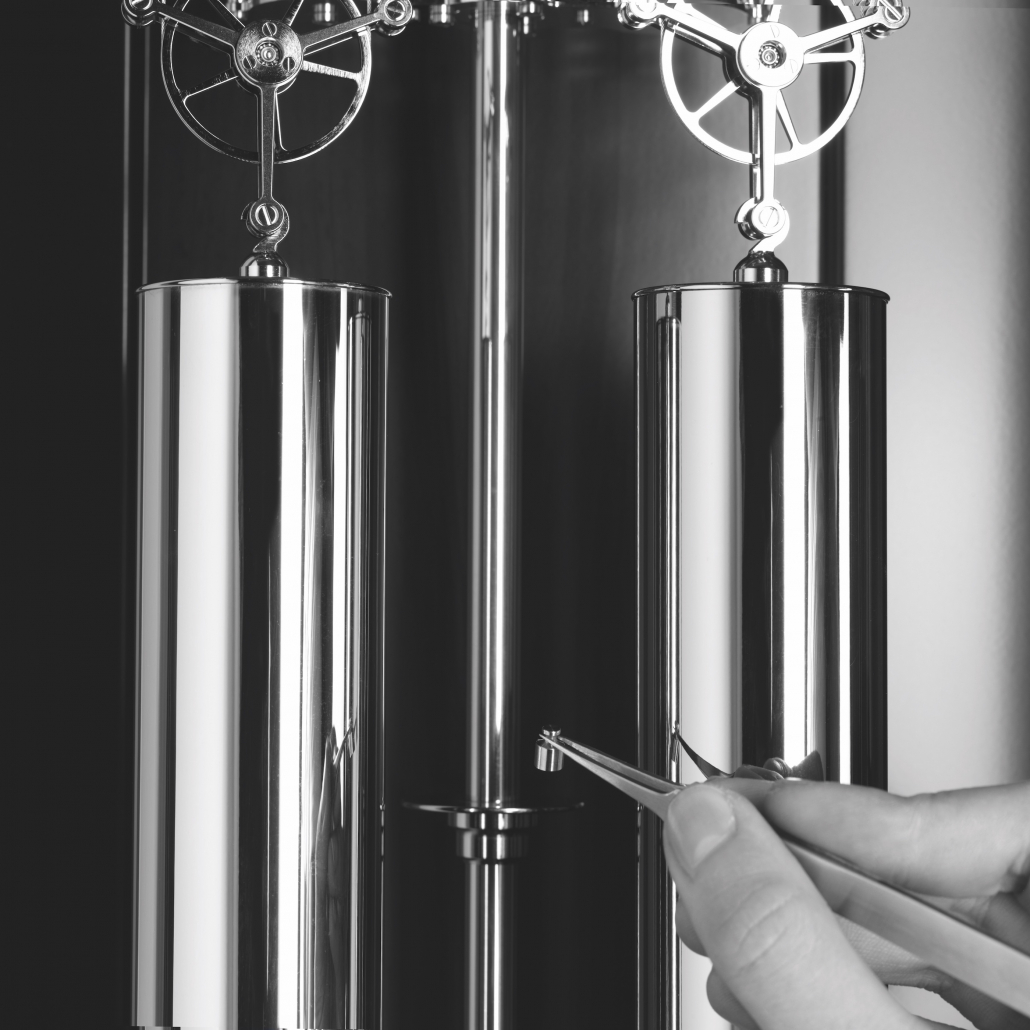THE PENDULUM – THE MOST ACCURATE MECHANICAL OSCILLATION SYSTEM
25th of APRIL 2020
As early as the 16th century, renowned astronomers and natural scientists were already studying the peculiarities and behaviour of the pendulum, or what was then called the gravity pendulum. In elaborate experiments and calculations, they came to the conclusion that the period of oscillation of a pendulum with thread suspension did not depend on the mass or shape of the pendulum body, but only on the length of the pendulum itself. A pendulum, once set in motion, always needs the same time for one oscillation. So it was obvious to use this effect in wheel clocks. At that time, clocks were relatively inaccurate and the search for the most precise oscillation system, by which time could be measured or displayed, was not finished.
Today we know various oscillation systems like the balance (for mechanical watches), the quartz (for watches with battery operation) or even the pendulum. The latter is still the most accurate mechanical oscillator which is still used for high-precision, fixed or suspended clocks.
In 1585, as mentioned above, Galileo Galilei made the discovery that the frequency at which a pendulum swings is determined primarily by its length and the local gravity surrounding it. In addition, he observed that the amplitude of a pendulum has no influence on the duration of a pendulum oscillation; this is described today with the term isochronism. With regard to the isochronism, however, we know today that it is only approximately valid for very small pendulum oscillations.
Because a pendulum, once set in motion, permanently loses its amplitude due to various disturbing influences such as gravity, air resistance or even the friction of the pendulum suspension, force must be applied to it at regular intervals. In the case of a fine pendulum clock, a weight is responsible for this, which transmits the force to the pendulum by means of the clockwork. At this point it should be mentioned that the weight in this case is the absolute energy store to be favoured, as it has a permanently constant (weight) force.
If a pendulum is now installed in a fixed clock, is driven with constant force and its length is adjusted to the exact geographical position, the clock should display the time with maximum accuracy. However, this is not automatically the case! Now further disturbing factors come up to the existing system. First and foremost these are temperature fluctuations, air pressure fluctuations and also fluctuations in humidity.
The disturbing air humidity can be remedied very quickly by painting wooden pendulum rods or even using metal rods.
A bigger problem are the deviations due to temperature fluctuations. At high temperatures materials expand, the pendulums become longer and thus slower, the clocks slows down. At cold temperatures the effect is reversed. The first step was to use special types of wood that did not react very well to these fluctuations. This was followed by experiments with complicated and costly constructions of various rods made of different metals that were supposed to compensate or equalize each other in order to avoid the change in length of the pendulum rod due to the temperature, the so-called grid-iron pendulum. Finally, at the end of the 19th century, the French scientist Charles-Edouard Guillaume discovered an iron-nickel alloy that was groundbreaking.
The coefficient of thermal expansion of this new material was 10 times lower than steel and 5 times lower than selected woods. This new “invariable” metal was therefore, obviously, given the name Invar.
Since the invar nevertheless has a low thermal expansion, clocks with rate deviations of several seconds per month were possible, but better values could not be achieved by invar alone.
In 1896, the entrepreneur Sigmund Riefler invented a further improved compensation system to compensate for temperature fluctuations. He used Invar for the pendulum rod and placed a so-called compensation tube on top the regulating nut located at the bottom of the rod. This tube was limited at the bottom by the regulating nut, but could expand freely upwards (when heated). In order to perfect the compensation, the compensation tube reached exactly into the middle of the pendulum body. In simple terms, the compensation tube therefore expands upwards when heated, by the same length, by which the pendulum rod expands downwards. The pendulum bob remains in exactly the same position at different temperatures! Now the way was paved for the construction of high-precision pendulum clocks and the achievement of exceptionally good rates was no longer influenced by temperature fluctuations.
Last but not least the third disturbing factor, the permanently changing air pressure. Here, too, an innovative invention made it possible to achieve a significant improvement with regard to the accuracy of the rate – but more about this and also in more detail in one of our next magazine articles!
Now we want to take a brief look at regulation, i.e. how a pendulum clock is precisely adjusted.
Roughly, this is done by adjusting the length of the pendulum, which means that the pendulum lens has to be moved upwards to shorten the pendulum and thus accelerate the clock. Moving it downwards therefore causes a slower swinging pendulum. In most pendulum clocks this is done by the so-called regulating nut. This is located at the lower end of the pendulum and supports the pendulum body. If now the nut is turned so that the pendulum body is lifted, i.e. shifted upwards, the pendulum will accelerate, because it has become shorter (with regard to its centre of gravity).
This method of regulating is sufficient for most clocks to achieve good rates, but not so for precision pendulum clocks. Here we use another inconspicuous invention to achieve much better pendulum movements. The so called Huygens’ runner or fine adjustment table. It is located exactly in the middle between the point of suspension and the centre of gravity of the pendulum on the pendulum rod – at this position the effect of the following fine adjustment is greatest.
If a pendulum has already been adjusted as accurately as possible by means of the adjusting nut, it should be held in oscillation as smoothly as possible. Conversely, this means that a further improvement in accuracy must/should be made to the swinging pendulum. If you want to make the pendulum swing faster, i.e. shorten it, you have to put small weights on the regulating disc. By removing weights already on the regulating plate, the exact opposite is achieved. With the help of this little trick, the finest changes in the swinging pendulum can be achieved.
So far it should be good at this point, but the subject of the pendulum itself is so comprehensive that entire books have been written about it.




